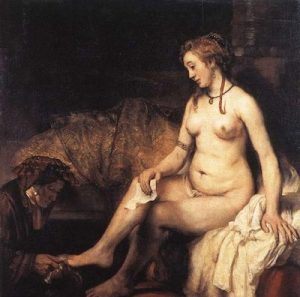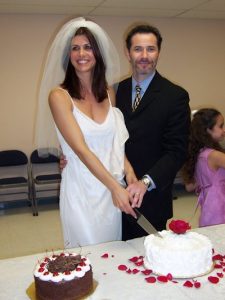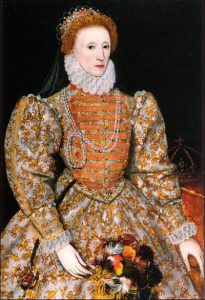
Old Poetry Similar Ideas
How interesting to read old poetry and learn about the prevailing attitudes towards youth and beauty through this art form. We’re all familiar with paintings by the Masters that depict full-figured women as their objects of beauty, so in a way, it’s strange that when reading old poetry the notion of acceptance that you might assume as commonplace years ago, isn’t generally reinforced by most of the old poets. Wider hips and a protruding belly were considered beautiful enough to be immortalized in paintings, but a woman’s age remained an essential component of her desirability and usefulness. In those poems time is the enemy of beauty and love.
To the Virgins
In Robert Herrick’s 1648 poem titled “To the Virgins to Make Much Out of Time,” the theme is about making the most out of life and seizing the day; although, I can also see a little more to the poem’s initial positive stance. Taking into account the era and women’s inferior standing in society, I can’t help but think that Herrick remains steadfast to preconceived notions of beauty and aging. In this poem he emphasizes the need to act fast before the passage of time, “Gather ye rosebuds, while ye may”—a nagging reminder of a woman’s precarious position with respect to time that we never see when mentioning men. “And this same flower that smiles to-day To-morrow will be dying”—this personification cuts straight to the point, and it emphasizes the fleeting nature of a woman’s beauty. If that were not enough reinforcement of the obvious, he goes on to say “That age is best which is the first When youth and blood are warmer“—a woman should take advantage of her youth and virginity if she ever wants to marry. And today, what’s different really? I remember that when I was single, my own grandmother would express a similar sentiment and tell me that I didn’t have much time left, and I was wasting my best years etc. Honestly, all I could do was giggle, she meant well and had married young and her own mother married at age eight! These days people tend to marry at an older age, at least in the West, and have kids in their forties, but with respect to work and career those archaic notions of age as a determining factor to one’s success, still hold true today, especially for women.

You Never Can Be Old
Those of you who’ve read my novel The Diary of a Wrinkle may remember the Shakespeare quote in one of the opening pages of my book:
“To me, fair friend, you never can be old, For as you were when first your eye I eyed, Such seems your beauty still.”
In other words, in Sonnet 104 Shakespeare is saying that as far as he’s concerned his friend will never age; in his eyes he will always look just as beautiful as the day they met for the first time. Indeed a very powerful message. He goes on to describe the transience of time but his love interest remains as green as before, “Three beauteous springs to yellow autumn turned, In process of the seasons have I seen; Three April perfumes in three hot Junes burned, Since first I saw you fresh, which yet are green.” Green coveys renewal and rebirth, youthfulness—the type of positive outlook we’d love to hear more often, I’m sure. We all want to be viewed as beautiful and relevant, regardless of age.
Shakespeare employed ambiguity in his writing, and he loved to tease his readers about his love interest’s identity. There is so much speculation about these sonnets and the identity of a young man he often addresses, or the true identity of a mistress whom scholars have called the Dark Lady, because he describes her with dark features and a dark nature. It’s widely believed that his love interest in Sonnet 104 is none other than a man, and in that case it’s just as interesting to see whether his generous ideas on beauty and aging differed with respect to women.
Fading Beauty
In Sonnet 18 we delight in his use of the sun as a metaphor to describe his beloved’s beauty, but the sun doesn’t quite compare to that beauty either as his love’s beauty is “more lovely and more temperate.” Shakespeare is concerned with the idea of fading beauty and he continues to distinguish between the unstable nature of the sun and his love’s beauty; it can be too hot, too dim, the season doesn’t always last very long, whereas his love’s beauty will never fade. But in the final quatrain Shakespeare is determined to make this beauty last forever, in a way he concedes to inevitable aging because he tells us that only the written word could survive the passage of time. But he uses this to his advantage by promising to immortalize his love’s beauty through the eternal power of his words. “When in eternal lines to time thou growest: So long as men can breathe or eyes can see, So long lives this and this gives life to thee.”

Shakespeare was talented and prolific but he also suffered from a healthy dose of prejudice towards women, which was pretty commonplace among the white male population during the Elizabethan era. Ironically, this was the case even when Queen Elizabeth was known as a talented linguist, with impressive fluency in several languages. For most women, only very basic education constituted the breadth of their knowledge and while the privileged may have furthered their education more—adding to their overall charm and appeal—though heavier emphasis was on home economics as there were no career opportunities for women once schooling was over.
Disparity in the treatment of women is further expressed in Sonnet 20. Here, the object of Shakespeare’s affection has natural beauty, as opposed to made-up and unnatural beauty. His love interest has the grace and features of a woman but is devoid of guile and pretense, and this too is a generalized idea of female characteristics and so is the idea that all women suffer from mood swings and empty, false flirtation.

To be fair, for proper insight on Shakespeare’s ideas of love and beauty, one must look at his entire body of work, which is impossible to do in one post but with the few sonnets I’ve mentioned we are still able to get a general feel for aging and beauty in Elizabethan times. However, if I’ve learned anything of value from Shakespeare’s writing, it’s that he can’t help but humanize even the most vile and hated characters and he’s employed this type of empathy when describing his female characters as well. In The Merchant of Venice, there’s no doubt that Shylock is portrayed in the same racist light the rest of society had viewed Jews, but then Shylock says: “I am a Jew, Hath not a Jew eyes? Hath not a Jew hands, organs, dimensions, senses, affections, passions; fed with the same food, hurt with the same weapons, subject to the same diseases, healed by the same means, warmed and cooled by the same winter and summer as a Christian is?” He’s giving the audience a chance to empathize with Shylock, with a Jew. Some scholars believe that his mistress, the Dark Lady, was really Emilia Bassano Lanier and she was the illegitimate daughter of a Jewish, Italian musician from Venice named Baptista Bassanoa. In the play, one of the characters is named Bassanio, and Shylock is definitely portrayed with a little bit of humanity.
Beauty Standards
We can find the same sentiment in Sonnet 130, which is a parody of the ridiculous standards attached to women generally or the clichéd way that other poets describe their beauty. “If snow be white, why then her breasts are dun.” “And in some perfumes is there more delight Than in the breath that from my mistress reeks.” He then qualifies all of those disparaging remarks with “And yet, by heaven, I think my love as rare As any she belied with false compare.” Shakespeare’s mocking of other poets is interesting to me, it means that despite the prevailing views about women and beauty, despite the many literary devices he used to portray negative images of women in some of his works, conversely he was also sensitive to the majority view of beauty and felt the need to express otherwise. His wife, Anne Hathaway, was eight years older than him but I am not entirely sure that this had any impact on his ideas of age and beauty because all we have is a lot of speculation about the state of his marriage. He also left his marital home and spent the majority of is life in London. I think that what it comes down to is a type of hubris, and his ability to argue conventional ideas in the most literary means possible.
And you see this further in Sonnet 95 when he demonstrates a balance of sorts because as he describes his love’s beauty, it’s not devoid of a realistic observation as well. He compares the young man’s behavior to a rotten spot on an otherwise beautiful flower. In other words, the young man’s beauty will allow him to get away with bad behavior, but bad behavior will also distort his beauty. There is a moral question he addresses in this sonnet, it’ one of personal and moral responsibilities and those will determine one’s visage at the end of the day.
Has Anything Changed?
Centuries later, we find that the very same ideas about beauty have remained intact. And we see it now, more than ever, the notion that youth is the one and only answer to achieving success, whether in the workforce for a better job and career, or with respect to our ability to find love, or a “good catch.” If that were not the case then we wouldn’t be bombarded with so many treatment options for enhancing our youthful appearance, it wouldn’t be necessary for a female news anchor to fill her face with Botox and fillers in order to secure a prime time position in front of the camera. Why can a male newscaster sport grey/white hair and still be regarded as a top notch journalist or anchor? Anderson Cooper’s hair color has never been a deterrent for employers or viewers, he’s been able to hold on to his position on CNN for years but where have we seen a grey-haired female journalist or anchor before? I haven’t.
Of course I can see the appeal in young and flawless, and when I’m watching one of those pretty women on TV, after the initial reaction of “wow she’s pretty,” I become more focused on the content rather than how beautiful and flawless her skin is. On occasion, when I’ve watched Barbara Walters on one of her specials, I’ve never been concerned with her age, albeit she’s had a few procedures done, it’s obvious, and her older looks would never be the reason for which I’d switch to a different channel either. Similarly, Joan Rivers never fooled anyone with her artificially enhanced younger looks, she talked about it openly and with much humor, but the point is, she still looked like an old woman who had altered her looks, so I never really understood her need to keep pulling and stretching her skin.
The Pressure to Change
I liked her for her humor and bluntness anyway, and for anyone who remembers what she looked like before she started to alter her looks, well, it just doesn’t make any sense. Unless she too was influenced by the domineering male presence in her field of work where there was stiff competition, including a few lots battles, maybe that’s what drove her to the plastic surgeons table.
I’m not a critic of all the Joan Rivers of this world, but I’m definitely carving out a different path for anyone who’d like to join me and feel that it’s okay to show age; it’s okay to have wrinkles or grey hair and still feel confident and beautiful. And it’s okay to demand that first-class job. Let’s read old poetry in the context in which it belongs, in a time long gone when women barely had a voice. So much has changed since that era, and change is a good thing most times, it shows progress and the acceptance of new ideas.

My hope is that this generation’s idea of beauty will be a brief phase at best and that less emphasis will be placed on one’s looks and that a varied interpretation of beauty will open doors for so many women who would otherwise be ignored and missed. Join my Wrinkle Revolution will ya.